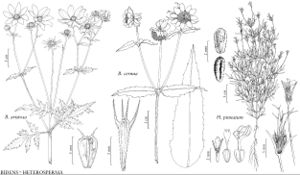Heterosperma pinnatum
Icon. 3: 34 1795/1796 (as pinnata).
Treatment appears in FNA Volume 21. Treatment on page 219.
Revision as of 22:29, 29 July 2020 by imported>Volume Importer
Leaves 1–4+ cm, lobes 0.5–1 (–3) mm wide. Ray laminae 1–2+ mm. Disc corollas ca. 2.5 mm. Cypselae 5–18 mm; pappi 0.5–1 (–3) mm. 2n = 48, 50.
Phenology: Flowering Jun–Oct.
Habitat: Igneous and calcareous soils
Elevation: 900–2500 m
Distribution

Ariz., N.Mex., Tex., Mexico, Central America
Discussion
Heterosperma pinnatum occurs throughout much of the southwestern United States. No specimens have been seen to substantiate claims of occurrences in Maryland and Massassachusetts, where it may have been ephemeral. Calyculi of H. pinnatum have been interpreted as leaves, the heads being interpreted as terminal and sessile.
Selected References
None.
Lower Taxa
None.
"broader" is not a number.
... more about "Heterosperma pinnatum"
introrse +
connate +
herbaceous +
scarious +
absent +
hirsute +
papillate +
cymiform +
barbellate +
continuous +
decurrent +
barbellate +
lobed +
winged;ribbed;winged;ribbed +
3;8 +
herbaceous +
erect +
linear;filiform +
stigmatic +
absent +
zygomorphic +
winged +
dimorphic +
outer +
5mm;18mm +
2.5 cm25 mm <br />0.025 m <br /> (?) +
staminate +
straight +
beaked +
inner +
glabrous +
corky-tuberculate +
tapered;obovoid +
distinct +
proximal +
1;5 +
bisexual +
dispersed +
singly +
indeterminate +
Present +
surrounding +
cylindric;obconic +
opposite +
cauline +
deltate +
scarious +
2-carpellate +
inferior +
attached +
anatropous +
oval;lanceolate or linear +
persistent +
falling +
absent +
tough +
thick +
absent +
connate +
persistent +
distinct +
falling +
erect +
unequal +
equal +
Icon. +
1795 +
pistillate +
absent +
fertile +
paleate +
concave;flat +
fibrous +
exalbuminous +
modifed +
alternate +
branched +
2-branched +
papillate +
Heterosperma pinnatum +
Heterosperma +
species +
shorter +
equaling +
denticulate +
annual +
